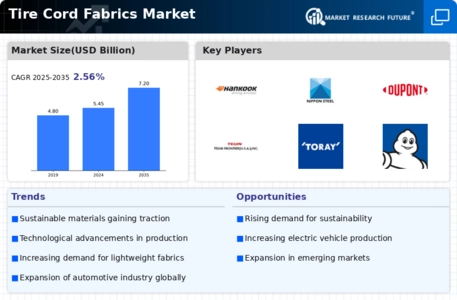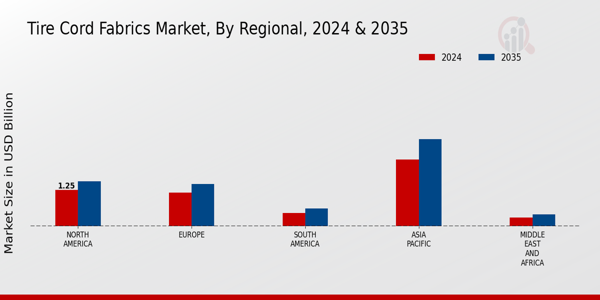Market Trends and Growth Projections
Increasing Vehicle Production and Sales
The increasing production and sales of vehicles globally serve as a significant driver for the Global Tire Cord Fabrics Market Industry. As emerging economies experience economic growth, the demand for personal and commercial vehicles rises, leading to higher tire production. This trend is particularly evident in regions such as Asia-Pacific, where vehicle ownership is surging. The correlation between vehicle production and tire demand suggests that the market will continue to expand, supporting the projected market value of 5.45 USD Billion in 2024. Consequently, tire manufacturers are ramping up production capacities to meet this growing demand, further stimulating the tire cord fabrics sector.
Growing Demand for High-Performance Tires
The Global Tire Cord Fabrics Market Industry experiences a growing demand for high-performance tires, driven by advancements in automotive technology and consumer preferences for safety and durability. As vehicles become more sophisticated, the need for tire components that enhance performance becomes critical. This trend is reflected in the projected market value of 5.45 USD Billion in 2024, indicating a robust growth trajectory. Manufacturers are increasingly focusing on developing tire cord fabrics that offer superior strength and flexibility, which are essential for high-performance tires. This shift not only caters to consumer demands but also aligns with regulatory standards for vehicle safety and efficiency.
Regulatory Compliance and Safety Standards
Regulatory compliance and safety standards play a crucial role in shaping the Global Tire Cord Fabrics Market Industry. Governments worldwide are implementing stringent regulations aimed at enhancing vehicle safety and performance. These regulations necessitate the use of high-quality tire cord fabrics that meet specific safety criteria. As a result, manufacturers are compelled to invest in advanced materials and technologies to ensure compliance. This focus on safety not only protects consumers but also drives innovation within the industry. The ongoing evolution of safety standards is likely to contribute to the market's growth, reinforcing the importance of quality in tire cord fabric production.
Technological Advancements in Material Science
Technological advancements in material science are significantly influencing the Global Tire Cord Fabrics Market Industry. Innovations in fiber technology, such as the development of aramid and polyester fibers, enhance the performance characteristics of tire cord fabrics. These materials offer improved tensile strength and resistance to wear, which are crucial for tire longevity and safety. As manufacturers invest in research and development, the market is expected to grow at a CAGR of 2.56% from 2025 to 2035. This focus on innovation not only meets the evolving demands of the automotive industry but also positions companies competitively in a rapidly changing market landscape.
Sustainability Initiatives in Tire Manufacturing
Sustainability initiatives are becoming a pivotal driver in the Global Tire Cord Fabrics Market Industry. As environmental concerns gain prominence, tire manufacturers are seeking eco-friendly materials and processes. This shift is evident in the increasing use of recycled materials in tire cord fabrics, which not only reduces waste but also lowers production costs. The market is likely to see a significant transformation as companies adopt sustainable practices, potentially leading to a market value of 7.2 USD Billion by 2035. This commitment to sustainability not only enhances brand reputation but also meets the growing consumer demand for environmentally responsible products.



















